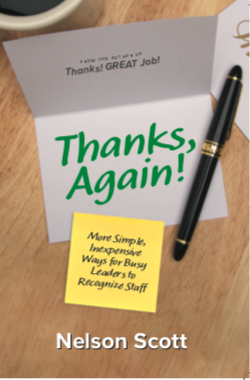
In a previous article, I used the concept of a simple jigsaw puzzle to illustrate how the ingredients of staff recognition fit together. In the centre of the puzzle is the essential component of meaningful staff recognition—Genuine appreciation for what the recipient did.
This uniquely shaped piece touches all the other pieces, all of which are identical in shape and size. None are as important as the Genuine piece or more significant than any of the other pieces.
As is true of all puzzles, the more pieces that are laid in place, the clearer the picture—in this case, it’s a picture of appreciation for how an individual or team contributed, or for what they achieved.
A message of appreciation becomes stronger with the addition of other ingredients that combine to make recognition GREAT (Genuine, Relevant, Explicit, Appropriate and Timely). But what does that mean? How does adding ingredients strengthen the message?
Let’s watch how it happens as I add ingredients to a simple message from a supervisor:
“I appreciated how you assisted your colleague just now.”
Whether delivered in person, written on a sticky note, or included in a text message, this recognition was Timely because it was delivered soon after the boss saw behaviour that they value.
The supervisor knows why the behaviour deserves recognition, but is the reason as evident to the individual being recognized?
To ensure it is, make the recognition Explicit:
“I appreciated how you assisted your colleague just now. You stepped in to offer to assist with the inventory when you saw that she was busy and trying to manage several tasks.”
The supervisor can add that the staff member’s actions were Relevant to what the organization believes is important:
“What you did is a great example of teamwork, which is one of our values as an organization. Working as a team is key to our success.”
Deciding how to deliver recognition requires that the supervisor knows staff members well enough as individuals to recognize them in Appropriate ways.
The right way may be with a thank-you note, recognition in front of the team, a gift card from their favourite coffee shop, or the opportunity to extend a break.
Jigsaw devotees understand that not all pieces need to be in place before they begin to envision how the completed picture will look. The same is true when recognizing staff.
Not all the ingredients need to be part of the message for recipients to feel that their contributions are appreciated.
In our example, recipients will understand that what they did was valued by the boss even if the message of appreciation ends with the first statement.
The supervisor could skip the Explicit description of what the recipient did because the reason for the recognition is as obvious to the recipient as it is to the person providing the recognition. It’s not always necessary to explain why the behaviour is Relevant to the organization’s values, goals or mission statement.
While Appropriate is always preferred, any recognition is better than none.
Even when not Timely, recognition is still worth doing. There is no statute of limitation on staff recognition. Even recognition delayed will be valued by recipients.
Nevertheless, recognition has its greatest impact on recipients when all five ingredients are part of the message—just as we would not abandon a puzzle with a few pieces still in the box.
==
During Staff Recognition: One Piece at a Timeworkshops, participants focus on fitting all the ingredients together to deliver recognition that is GREAT—Genuine, Relevant, Explicit, Appropriate and Timely. Contact Nelson (nmscott@telus.net or phone/text 780-232-3828) to schedule a Staff Recognition: One Piece at a Time workshop for your team or to learn more about this or other staff recognition programs.












